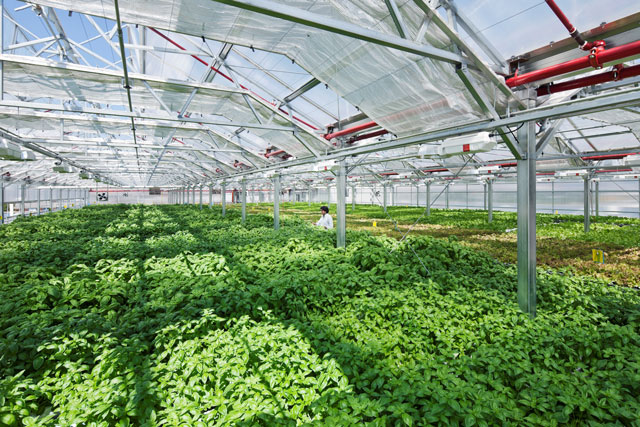
The climate-controlled rooftop greenhouse allows Gotham Greens in Greenpoint, Brooklyn to grow an assortment of greens and herbs year-round.
Urban farming in New York City is not just another hipster hobby to be added to the list along with home brewing and screen-printing. While your typewriter and sewing machine sit unused in the corner of your room, urban farms are taking over rooftops, abandoned lots, and even truck beds throughout the five boroughs, ranging from the communal to the commercial level, and improving the quality of life city-wide.
One would think that the obvious problem with urban farming — the utter lack of farmland — would be New York City’s big downfall. However, urban farms in New York City are actually revolutionizing the food network, giving us New Yorkers even more bragging rights.
To combat the space problem, many farmers have taken to rooftop farming, employing hydroponic methods — growing plants in nutrient-rich solutions rather than soil. Hydroponics has actually increased farming efficiency, requiring less space and water than a traditional farm. Gotham Greens, located in Greenpoint, Brooklyn, boasts producing 20 times as much produce in their rooftop greenhouse than would a traditional farm of the same square footage.
Agricultural engineering has tackled the farmland problem by overcompensating when it comes to controlling traditionally indomitable environmental factors, such as extreme weather and pests. Gotham Greens coddles their greens and herbs in a rooftop greenhouse using Controlled Environment Agriculture, maintaining ideal growing conditions for their produce and allowing them to provide superior quality produce year-round.
One of the biggest advantages of farming directly in the city is decreased shipping distances. “Locally grown” has been a buzzword for years, and it’s easy to see why: the benefits are invaluable, especially in a city plagued by food deserts. Urban farms generate easily accessible produce to the community, all while reducing the carbon footprint. Local also means fresher. According to Jon Perri, the produce manager of Dean and Deluca, “There’s a demand for certain products that just don’t ship very well. For example, basil, because basil needs to be stored at a different temperature once it’s harvested than most other produce, so local growing cuts down on the damage of cold storage on basil.” Talk about being “green,” literally and figuratively.
According to the Natural Resources Defense Council attorney Johanna Dyer, the environmental benefits of urban farms expand beyond those of providing easy access to local and nutritious food. “Urban farms can help support wildlife in the area — from migrating birds to butterflies. They also help clean up the city’s rivers and beaches by absorbing rain before it can reach storm drains, preventing runoff pollution and sewage overflows. On top of that, the added green space cleanses the air, and helps make the city an all-around more enjoyable place to live.”
Mayor Michael Bloomberg has gotten behind the “going green” trend, instating a package of laws last year to promote the consumption of local food, as well as facilitate the process of starting an urban farm. These laws allow farmers to forego neighborhood building code restrictions that previously obstructed the construction of rooftop farms. Farmers also have access to a searchable government database of city-owned property with farming potential, including buildings and empty lots. Besides the environmental and health benefits of encouraging urban farming, commercial farms also create tax revenue for the city. Says Gotham Greens CEO Viraj Puri, “We’ve got the support of a lot of politicians and elected officials who are really excited about the job creation. We’ve created 20 full-time jobs.”
Other urban farms remain on the ground and focus on building the community. Added Value turned the need for quality produce in Red Hook into an opportunity to reach out to the residents. Since it started laying the groundwork in 2001, Added Value has provided local teens with the chance to learn new skills while promoting social responsibility. Taqwa Community Farm in the Bronx and Battery Urban Farm in lower Manhattan also teach farm-based education to students of all ages, instilling the ideals of urban farming into the next generation.
The big question about urban farming is of its future. As the prevalence and promotion of urban farming continue to grow, more and more proposals for urban farms keep popping up around the city, and more people are getting involved in their community gardens. BrightFarms, an experienced founder of urban farms, is seeking a retail partner for its proposed farm in Sunset Park, Brooklyn to be the largest urban farm in the world. Likewise, the city’s Economic Development Corporation is in search of private developers to build a much-welcomed farm atop a warehouse in Hunts Point in the Bronx. Current farms are also looking to expand, like Gotham Greens, which has two new bigger and better greenhouses in the works.
However, despite the countless positive outcomes of urban farming, it is still a fledgling endeavor. Viraj Puri of Gotham Greens recites the anthem “one step at a time.” “We’d like to be able to feed more New Yorkers, diversify the products we’re growing, sell to more restaurants, more supermarkets, more farmers markets. We’re taking it one step at time but we’d definitely like to increase operation, especially in New York.” With patience, urban farming has the potential to revolutionize food production in this country, and what better guinea pig for such advancement than New York City — a city full of innovative thinkers and veggie-lovers?
